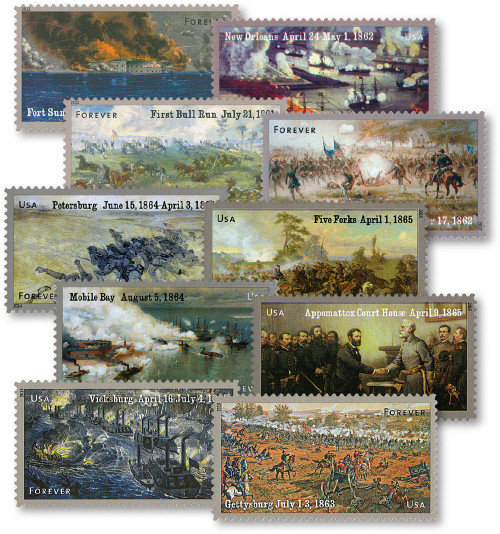
2012 First-Class Forever Stamp,The Civil War Sesquicentennial, 1862
# 4664-65 - 2012 First-Class Forever Stamp - The Civil War Sesquicentennial, 1862
$3.95 - $39.00
U.S. #4664-65
2012 45¢ The Civil War: 1862
Issue Date: April 24, 2012
City: New Orleans, LA
Quantity: 30,000,000
Printed By: Ashton Potter
Printing Method: Offset
Perforations: Die cut 11
Color: multicolored
The Civil War Series stamps were issued to commemorate the 150th anniversary of the War Between the States.
As the war entered its second year, the Federal government launched its first massive campaign to defeat the Confederacy. The North and South each had one million men facing off along a battlefront stretching from Virginia to Missouri. The loss of lives was enormous – five of the war’s bloodiest battles occurred in 1862, resulting in over 119,000 casualties.
The Confederacy fought back hard. Most of the battles had occurred on its territory. General Robert E. Lee decided it was time to take the war to the Union. His invasion ended in defeat with the Battle of Antietam, which was the single bloodiest battle on American soil to that time.
McClellan continued to overestimate the strength and size of his opponent. Lincoln had grown frustrated with his top general, but was heartened by the victories of Ulysses S. Grant in the West. His hopes were further buoyed by the victory of the ironclad Monitor in the Battle of Hampton Roads.
Although neither side was prevailing, two events eventually changed the war’s course. Union forces captured New Orleans and took control of the Mississippi River in April. This was followed on January 1, 1863, by the Emancipation Proclamation, which barred slavery throughout the Confederacy.
U.S. #4664-65
2012 45¢ The Civil War: 1862
Issue Date: April 24, 2012
City: New Orleans, LA
Quantity: 30,000,000
Printed By: Ashton Potter
Printing Method: Offset
Perforations: Die cut 11
Color: multicolored
The Civil War Series stamps were issued to commemorate the 150th anniversary of the War Between the States.
As the war entered its second year, the Federal government launched its first massive campaign to defeat the Confederacy. The North and South each had one million men facing off along a battlefront stretching from Virginia to Missouri. The loss of lives was enormous – five of the war’s bloodiest battles occurred in 1862, resulting in over 119,000 casualties.
The Confederacy fought back hard. Most of the battles had occurred on its territory. General Robert E. Lee decided it was time to take the war to the Union. His invasion ended in defeat with the Battle of Antietam, which was the single bloodiest battle on American soil to that time.
McClellan continued to overestimate the strength and size of his opponent. Lincoln had grown frustrated with his top general, but was heartened by the victories of Ulysses S. Grant in the West. His hopes were further buoyed by the victory of the ironclad Monitor in the Battle of Hampton Roads.
Although neither side was prevailing, two events eventually changed the war’s course. Union forces captured New Orleans and took control of the Mississippi River in April. This was followed on January 1, 1863, by the Emancipation Proclamation, which barred slavery throughout the Confederacy.












